 Conventional attack submarines: USS Barbel, Blueback, Bonefish (SS-580 to SS-582) 1956-1990
Conventional attack submarines: USS Barbel, Blueback, Bonefish (SS-580 to SS-582) 1956-1990Cold War US Subs
GUPPY | Barracuda class | Tang class | USS Darter | T1 class | X1 class | USS Albacore | Barbel classUSS Nautilus | USS Seawolf | Migraine class | Sailfish class | Triton class | Skate class | USS Tullibee | Skipjack class | Permit class | Sturgeon class | Los Angeles class | Seawolf class | Virginia class
Fleet Snorkel SSGs | Grayback class | USS Halibut | Georges Washington class | Ethan Allen class | Lafayette class | James Madison class | Benjamin Franklin class | Ohio class | Colombia class
The Barbel-class submarines were the last diesel-electric propelled attack submarines for the United States Navy. They also incorporated a lot of innovations, starting with their teardrop hull derived from USS Albacore (AGSS-569), and combined a control room and attack center under the conning tower. They also had a much thougher pressure, double double hull design, made with 1.5-inch thick HY80 steel. The trio started operations in 1959 and was ultimately retired in 1988–1990, as a more affordable option in case of war and the need for mass-produced attack subs to patrol US waters. They were an oddity in the 1980s, being the only conventional units in a fully nuclear-powered submarine fleet. The Barbel class design was so successful it drew a lot of attention overseas: The Netherlands choose this design for the Zwaardvis-class while the ROCN (Taiwan) made the Hai Lung class after these, as well as the Japanese Uzushio class and successors.

Development as SBC 150 programme
Designed under project SCB 150 it was built at the same time as the Skipjack-class nuclear submarines, entered service just three months after Barbel. They shared the same hull but smaller for the Barbels, and with a small sail as well. USS Skipjack was laid down 11 days after Barbel. All features of the USS Albacore prototype were of course reused, first of which its final and stage, fully streamlined “teardrop” hull as well as its single-shaft configuration, to minimize drag. The latter point however was discussed at length in the admiralty and stirred endless debate as until then it was considered two shafts offered redundancy and improved agility underwater.
For the first time allo, the Barbels had no conning tower, this extension of the pressure hull inside the sail. Instead all functions of the attack center and control room were concentrated into the same space, which became standard on later US submarines. In this was notably a simpler “push-button” automated ballast control inherited from USS Albacore instead of routing the trim system piping through the control room and traditional valves, manually operated. This new style simplified things, made veteran nervous, but dispensed of hydraulic operators necessary on each valve, which were now all remotely electrically operated via toggle switches, all from the same panel in the control room. This also reduced time required from triming and reduced the crew significantly as well a human error. There again, the specter of redundancy and backups resurfaced…
The overall layout of the single room also authorized the use of weapons and all ship control systems from the same room, as well as all sensors displays, navigation tracking, and communication.
The commander for the first time had all the essentials in the same space, shortening intercom time.
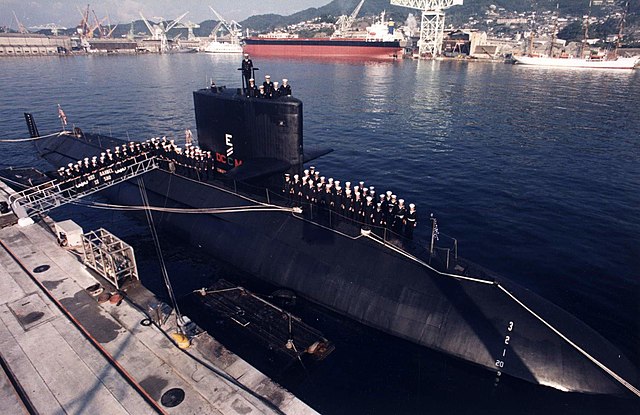
USS Barbel (SS-580) in Sasebo in 1988, her last year of service
Design of the class
Hull and general design
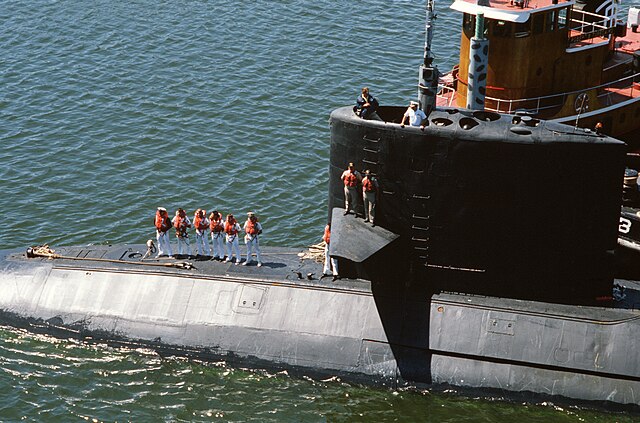
The Barbel class was more leaning towards the Albacore than subsequent SSNs, at 1,750 tons (1,778 t) light with 402 tons (408 t) of dead weight, 2,146 tons (2,180 t) full and 2,637 tons (2,679 t) submerged. The hull measured 219 ft 2 in (66.80 m) overall for an equal beam and height due to the shape at 29 ft (8.8 m) ending with the single propeller.
Apart its general shape, well refined, and basically later took over by all subsequent US submarines, the only “sticking” point that
The Barbels had also bow mounted diving planes originally, later replaced by sail planes (fairwater planes) relocated on the sail instead, another feature that became standard on US Navy submarines. Bow planes would returned on the improved Los Angeles class (1987) however. The Complement was 8 officers, 69 men.

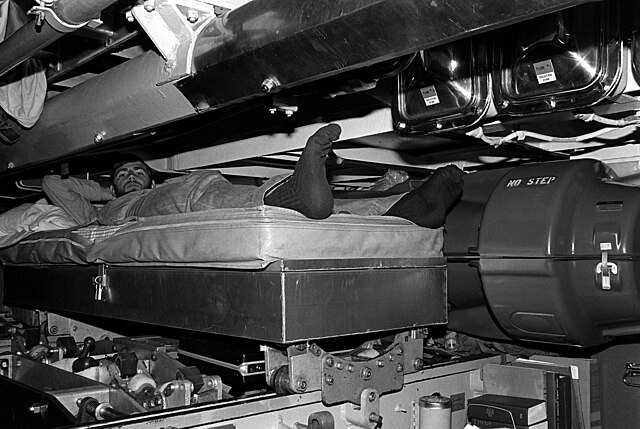
Fore Quarters in the torpedo room on USS Bonefish.
Powerplant
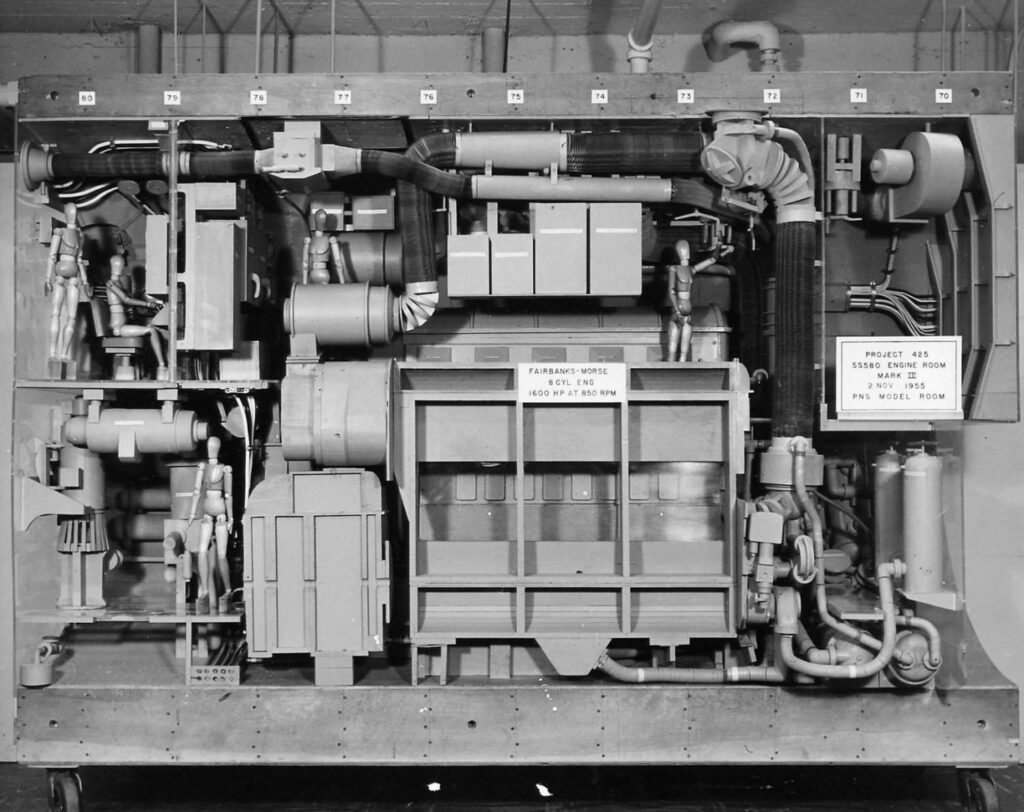
SBC 150 programme: Mockup engine room of the Barbel, with wooden mannequins giving the scale. The entire interior cutout was created to study ergonomics. (navsource)
The Barbel class featured three Fairbanks-Morse Diesel engines rated for 1,050 shp each, for a total of 3,150 shp (2,350 kW), coupled with two General Electric electric motors rated for 1,556 hp each, and a total of 4,700 shp (3,500 kW)). This came with a set of four 126-cell GUPPY IA batteries, driving a single shaft with a five-bladed propeller.
Performances wise, it was capable of 14 knots (26 km/h; 16 mph) surfaced, 12 knots (22 km/h; 14 mph) when snorkeling under the surface and 18.5 knots (34.3 km/h; 21.3 mph) submerged thanks to the optimized shape and electric power.
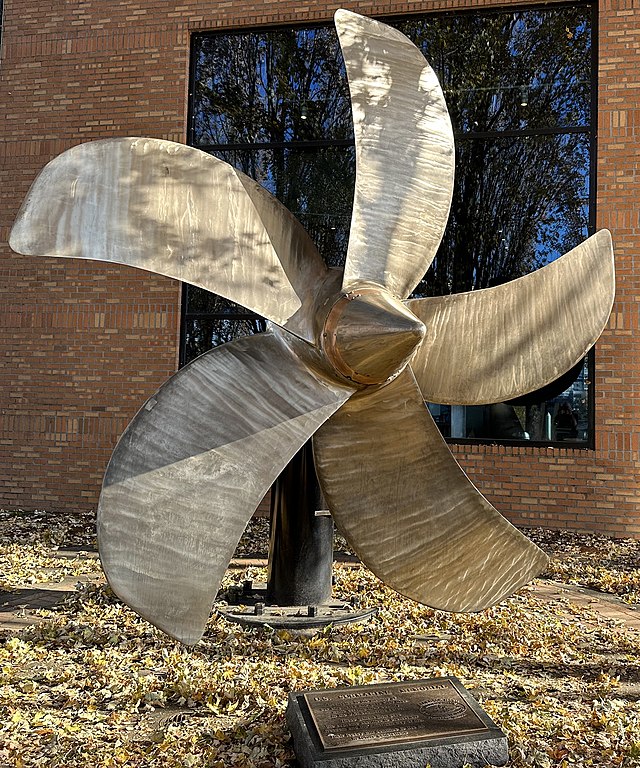
Main propeller of USS Blueback now in the national sub memorial
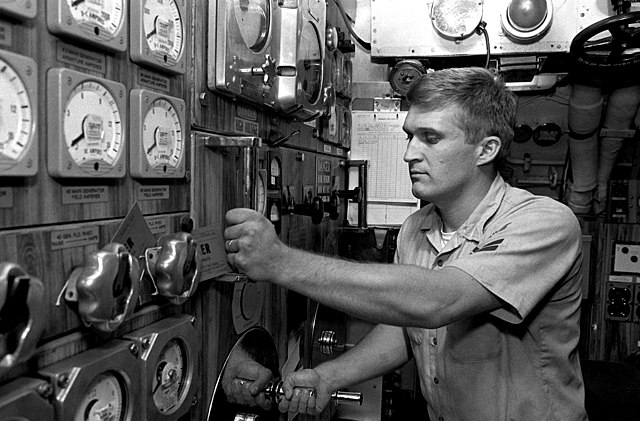
Petty officer checking the control panel, 3rd main generator on USS Blueback
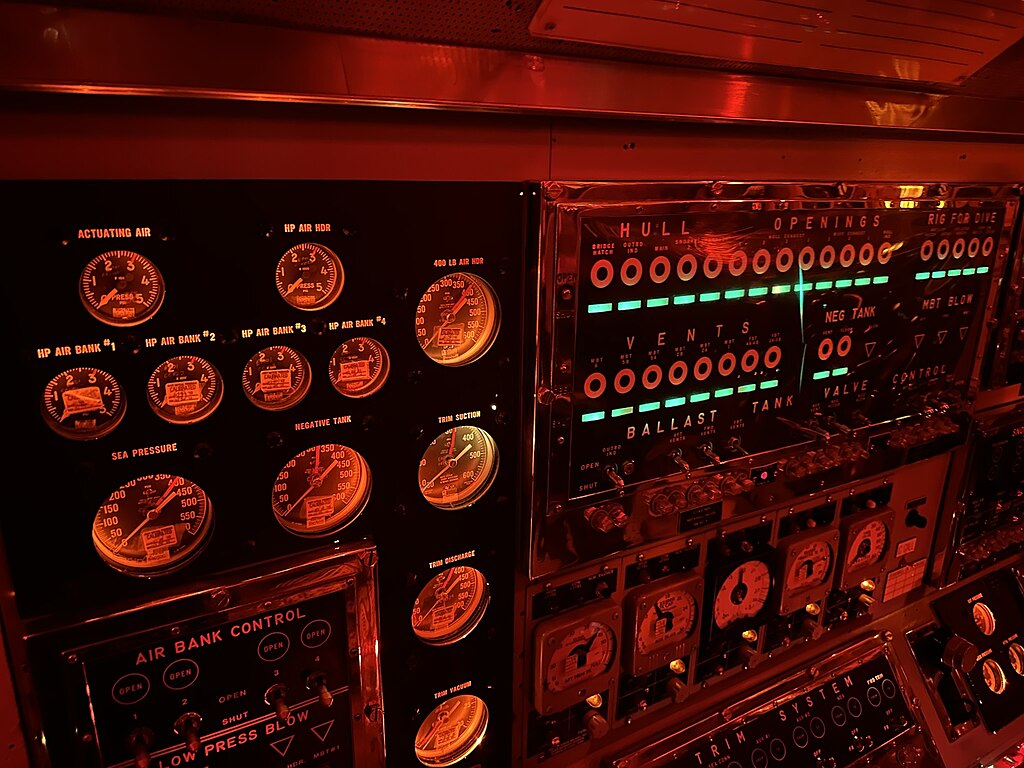
Main ballast Panel on USS Blueback
Range was considerable, 14,000 nautical miles (26,000 km) surfaced at 10 knots (19 km/h). To compare, the Tang classwere only capable of 11,500 nmi (21,300 km) at 10 kn. The Barbel class submarines can run over 90 minutes at full speed submerged, or creep over 102 hours at 3 knots (5.6 km/h) submerged for silent approach.
Thanks to the new pressure double hull, these attack submarines could reach a test depth of 700 ft (210 m), like the Tang class, which featured a thicker pressure hull.
Armament

The torpedo tube arrangement was the same as on the Skipjacks, with six bow tubes, three-over-three. It was also applied on the derived George Washington-class SSBNs. All three were a unique case in the US Navy with this configuration, as later to free the whole prow space for a more powerful sonar, the tubes were relocated in four angled positions midships, while most SSBNs kept four bow tubes. The Barbel’s six 21 inch (533 mm) bow torpedo tubes came with 22 torpedoes in reserve.
These were most likely of the 21″ (53.3 cm) Mark 39 type:
A modification of the Mark 27 Mod 4, first wire-guided torpedo to enter service, they used a wire dispenser with new controls provided to the remote operator, and improved propulsion, developed by ORL and Vitro Corporation. 120 were converted by Philco for fleet evaluation, on the seven SSK conversions and a new fire control system was designed a it was necessary to accommodate the wire. After the evaluation process, some 3,000 were produced.
The “bearing rider”, manually steered by an operatir keeping the line of bearing to the target was however not particularly efficient and among drawbacks, only a single torpedo at a time could controlled, this hamped evasive manoeuver from the launching submarine, its own noise masked the acoustic signature of the target. The type remained in service for two decades, until the smaller acoustic Mark 45 came about.
⚙ specifications Mark 39 (1956) |
|
| Weight | 1,275 lbs. (578 kg) |
| Dimensions | 11 ft 1 in (3.378 m) |
| Propulsion | Electric-Battery |
| Range/speed setting | 13,000 yards (11,890 m)/15.5 knots |
| Warhead | 130 lbs. (59 kg) HBX |
| Guidance | Wire/passive acoustic |
Sensors
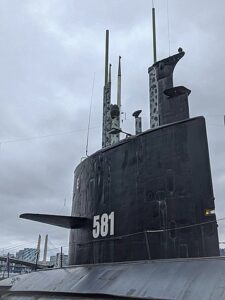 The Barbel class had the latest underwater detection technology at the time:
The Barbel class had the latest underwater detection technology at the time:
BQS-4 active sonar: Active/passive model, AN/BQR-2 passive detection system plus added active detection capability. Active component: 7 vertically stacked cylindrical transducers inside the BQR-2 chin bow dome, in which the BQS-4 transmits its active pings. There is also an automatic echo-ranging mode.
BQR-2 passive sonar: See above.
MK 101 fire control system: The appearance of the wire guided MK 37, MK 45, and MK 48 torpedoes led to design the MK 101 and MK. 106 Fire Control Systems. The MK. 101 was aimed at automatic transmission between units, reception of all target data simultaneously and automatic analysis of target course and speed while keeping range.
It could handle either straight runing older models, or wire guided torpedoes, with the first installed on the TANG class, SSN NAUTILUS and SEAWOLF and up to the PERMIT class. src
⚙ specifications |
|
| Displacement | 1,750 tons (1,778 t); 2,637 tons (2,679 t) submerged |
| Dimensions | 219 ft 2 in x 29 x 29 ft (66.80 x 8.8 x 8.8 m) |
| Propulsion | 1 shaft, 3× Fairbanks-Morse Diesels 3,150 shp, 2× GE EM 4,700 shp, 4× GUPPY IA batteries |
| Speed | 14 knots surfaced, 12 knots snorkeling, 18.5 knots submerged |
| Range | 14,000 nm (26,000 km) surfaced at 10 knots (19 km/h) |
| Test depth | 700 ft (210 m) |
| Armament | 6× 21 inch (533 mm) bow torpedo tubes, 22 torpedoes |
| Sensors | BQS-4 active sonar, BQR-2 passive sonar, MK 101 fire control system |
| Crew | 8 officers, 69 men |
Construction and Evaluation
 USS Barbel (SS-580) was laid down at Portsmouth Naval Shipyard on 18 May 1956. She was launched on 19 July 1958 and completed on 17 January 1959. She was the second retired, on 4 December 1989, and fully Decommissioned on 4 December 1989, but her scrapping was delayed due to asbestos insulation issues, and she was instead sunk as a target 30 January 2001.
USS Barbel (SS-580) was laid down at Portsmouth Naval Shipyard on 18 May 1956. She was launched on 19 July 1958 and completed on 17 January 1959. She was the second retired, on 4 December 1989, and fully Decommissioned on 4 December 1989, but her scrapping was delayed due to asbestos insulation issues, and she was instead sunk as a target 30 January 2001.
USS Blueback (SS-581) was laid down at Ingalls Shipbuilding, Pascagoula, Mississippi on 15 April 1957. She was launched on 16 May 1959 and completed on 15 October 1959. She was the last disposed of by 1 October 1990 and Decommissioned on 1 October 1990, but not scrapped. Given her historical value as the last and best ever conventio,al US submarine, she was provided funds to be preserved as a museum ship at the Oregon Museum of Science and Industry in Portland, Oregon, on display from 1994.
USS Bonefish (SS-582) was ordered to New York Shipbuilding, Camden, New Jersey on 3 June 1957 and launched on 22 November 1958. She was completed and commissioned on 9 July 1959. She was tthe first to go, descommissioned on 28 September 1988, but not intentionally. She was indeed being repaired after a fire that killed three on 24 April 1988. The repair was not deemed economically sound. She was instead hulked 17 August 1989, and used for tests by Northrop Grumman for a decade or so. Still extant.
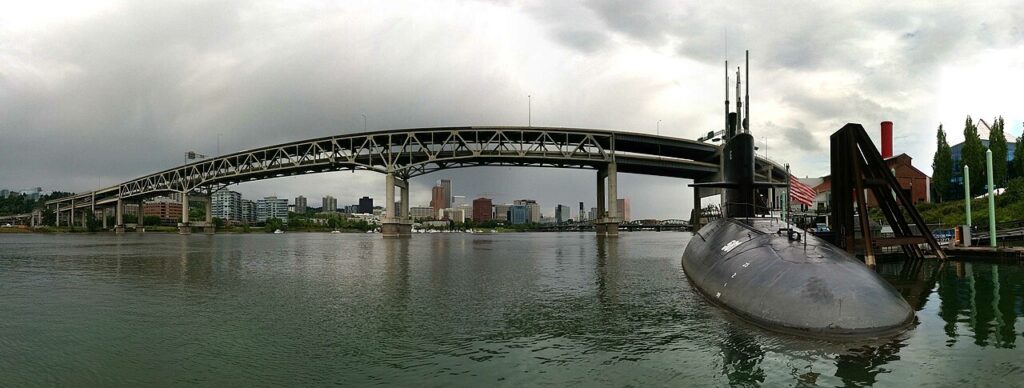
USS Blueback museum today.
They were not refitted with PUFFs, passive fire control gear perhaps because of the three large sonar domes involved that would have ruined streamlining. They differed from the Albacore in that they retained a substantial casing with noticeablke free-flooding slot reunning along the most of their lenght. This was a serious acoustic issue as well, when in use, and thus was never repeated in this shape. Overall, these subs were a good example of what the USN could have done if hard pressed in wartime for extra submarines. They cost far less at the time than a Skipjack class, less so than any Permit class that followed, or a Los Angeles class, which explains they served for so long, right until the end of the cold war. If not adopted by the USN which nuclear-first policy became the norm, they emulated many navies across the globe by represented the alternative conventional design to the European ones, notably the famous and well exported German Type 209, which philosophy was quite different.
 USS Barbel (SS-580)
USS Barbel (SS-580)
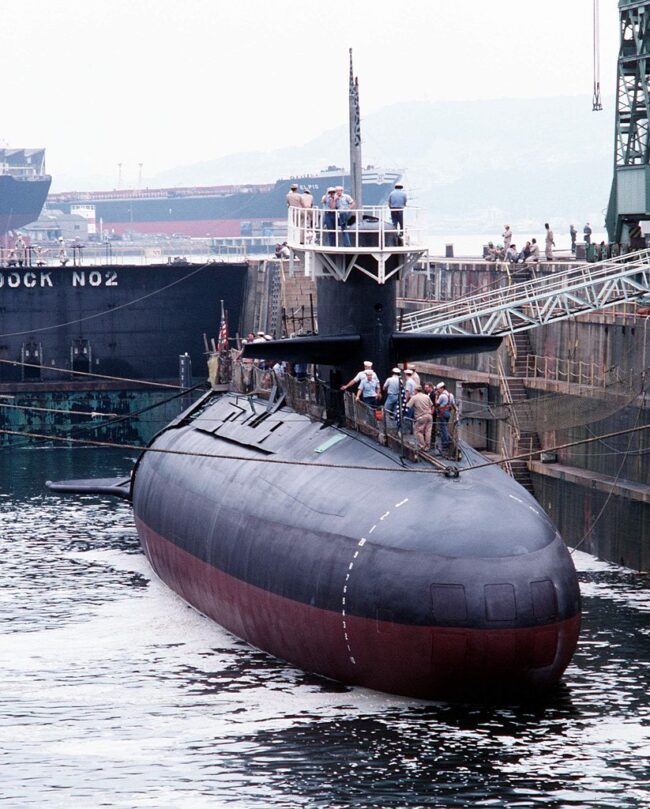
On 30 November 1960, USS Barbel took part on the Eastern coast in training exercise SLAMEX. After her first test depth dive at 700 feet, she ruptured a 5 inches line used for cooling equipment, circulated sea water. An emergency blow was done to reach the surface after which it was discovered she took 350 long tons of water inside her engine room. She entered Portsmouth Naval Shipyard for major repairs and replacement of all her piping, increased by 2 inches. Her bow planes were removed and relocated on the fin as fairwater planes instead.
In 1966 she accidentally rammed and sank North Vietnamese largest freighter when trying to determine her cargo. Damaged, she remained submerged and reached port for repairs. She also suffered propulsion plant reliability issues. In 1969, making her WESPAC in a “special mission” fir usually for a nuclear submarine issues amounted, so much so control room watch standers made a recognition badge related to a broken down nuclear submarine, with a contest held to design it, won by Leon Figurido, showcasing the “DBF” (“Diesel Boats Forever”).
In 1973 Barbel met a SUBPAC record after fring this year some 118 torpedoes, notably salvo firing with Mark 16-8 exercise torpedoes and operational test, and a zero error Mark 45 torpedo Technical Standardization Inspection as well as the Navy Technical Proficiency Inspection, and being awarded the 1973 Battle Efficiency “E”. She also “sank” USS Enterprise at RIMPAC 1978, which was not base for a “diesel boat”.
From 19 January 1981 to 22 January, with USS Grayback she took part in ASWEX 81-3U off the Philippines in shallow water, “sinking” the oiler USNS Navasota, escorted by USS John Young, Elliot, frigates Gray, Whipple, Lang, Ramsey in the narrow straits.
From 1988 she was under commanded by Commander William F. Bundy, first African-American submarine commander. On 1 May 1989, she operated off Kyūshū surfaced, whe three submariners were washed overboard in heavy waves. One was rescued but two drowned. There was also severe flooding so it was decided to decommission her. At the time it was established she had no proper positive buoyancy, and was back bad luck hit by a unusually large wave and she was driven below periscope depth before recovering and resurfacing.
Decommissioned on 4 December 1989, she was stricken on 17 January 1990. The scrapyard later discovered she was filled of painted-over asbestos insulation and it ceased. She would have her had her sail and superstructure reconstructed out of plywood to play in the movie “Crimson Tide” (1995) and was returned to the Navy, towed off San Pedro in Los Angeles and on 30 January 2001 sunk as target off the coast under 3,606 m.
 USS Blueback (SS-581)
USS Blueback (SS-581)
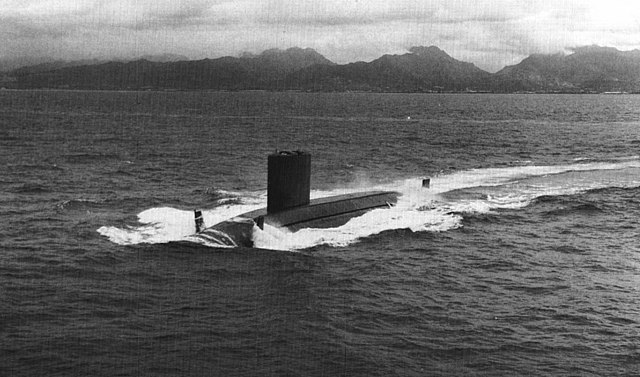
After fitting out, USS Blueback proceed for acceptance trials on January 1960 in the Gulf of Mexico. She was at Pascagoula on 11 June, and sailed to the Pacific via the Panama Canal on 7 July and to Naval Station San Diego joining SUBRON 3. USS Blueback carried out torpedo tube acceptance trials at Keyport (Washington) and post-shakedown availability at Mare Island, fully accepted on 23 November 1960.
She trained off San Diego until February 1961, followed by availability at Mare Island and forst deployment on 28 March, 7th Fleet operations from Yokosuka on 3 September, making a trip back to San Diego on 25 September, all submerged, earning a record for a conventional sub.
After leave and upkeep she resumed training exercises off San Diego in October, took part in a large ASW exercises watched by the CNO. She visited San Francisco and Seattle and started her first overhaul in July 1962 at Mare Island until January 1963. She later stopped at Vancouver, and proceeded to Pearl Harbor top join SUBDIV 13. From 11 April she made another WestPac to Australia for the anniversary of the Battle of the Coral Sea, hit Brisbane, Melbourne, and Perth. She resumed activities in the Philippines with the 7th Fleet and stopped at several ports in Japan before being back at Pearl Harbor on 26 October.
By March 1964 she saw a crane toppling over onto her while changing her propeller so she was drydocked, repaired. She lmater made trips to Wake Island and evaluate the SUBROC missile system with Permit-class subs as target ship. On 17 February 1965 she made another deployment, with stops at Naha, Hong Kong, Subic Bay, and Yokosuka and her first out of duty off Vietnam and back in June. She had a second overhaul at Puget Sound.
In 1966 she was used for a research and development project near Nanoose, Canada. She was sent to Pearl Harbor for refresher training and another tour of duty off Vietnam from 17 February 1967 over seven-months, until 20 September, leave and restricted availability in Pearl.
By mid-January 1968, she started service with the Pacific Fleet Submarine Force’s school as ASW target and went on training and with weapons exercises. On 8 July she made a 5-month deployment to the Far East and back to Pearl on 3 December. She started a new overhaul in 1969, at Bremerton and after intensive training she started her fifth deployment to the western Pacific, starting on 10 April. After special operations, brief visit she was in Vietnam war zone and back on 1 October. April 1971 saw her taking part in SUBASWEX 1-71, Pearl Harbor area. After torpedo firing exercises she was in upkeep at Pearl Harbor.
She started a Far eastern assignment on 25 June and was off Vietnam to train destroyer units of the 7th Fleet, she was back at Pearl on 14 December.
She spent 1972 in a lengthy overhaul at Pearl Harbor until March 1973, and started local operations, trained in preparation for deployment. On 8 August she took part in several operations with ships from Korea and Taiwan and back on 31 January 1974. March saw her at RIMPAC including ships from Canada, Australia, and New Zealand. From January 1976 she had another long overhaul at Pearl Harbor until 1 December. By February 1977, she took part in RIMPAC 77 and departed Pearl Harbor on 28 March for San Diego on 8 April. She was in San Francisco on 27 May, and returned to San Diego on 1 June, then Santa Marta in Colombia by 7 August with Task Force 138 for UNITAS XVIII. She visited also Panama, Ecuador, Peru, and Chile. She sailed off Talcahuano on 27 September for San Diego.
After 1978 upkeep she stayed in the San Diego area and had a battery replacement from 23 April to 23 May, for an upcoming deployment. She was at the Portland city’s Rose Festival. Then Esquimalt, British Columbia, Seattle for a two-day liberty call and San Diego. On 11 September she started her 8th westPac via Pearl Harbor and Japan, Chinhae, Korea for a joint special warfare/ASW exercises with the South Korean Navy and from 5 November with the Taiwanese Navy and afterwards a 7th Fleet exercise, Sasebo, Subic Bay for upkeep.
She also took part in special warfare exercises with Army Special Forces troops. She was back at San Diego on 1 March.
She was at a minelaying exercise off southern California in late September and was drydocked on 1 October. 1980 saw her in local operations and exercises and she sailed submerged to Okinawa on 11 May, taking part in ASW exercises in the Philippine Sea and later with South Korean forces, the ASW operations with the JMSDF sub Isoshio, also visiting Beppu, Japan and Subic Bay, the Chinhae to train with the South Korean Navy. While off Luzon on 25 August she saw ASW operations with the Royal Navy. She was back home on 15 October.
She was decommissioned on 1 October 1990, laid up, Pacific Reserve Fleet, Bremerton, Washington, stricken on 30 October 1990. With USS Dolphin (AGSS-555) she was the last diesel submarine of the US fleet. By February 1994 she was towed by the Oregon Museum of Science and Industry to Portland, now part of the museum and memorial and in the National Register of Historic Places from September 2008.
 USS Bonefish (SS-582)
USS Bonefish (SS-582)
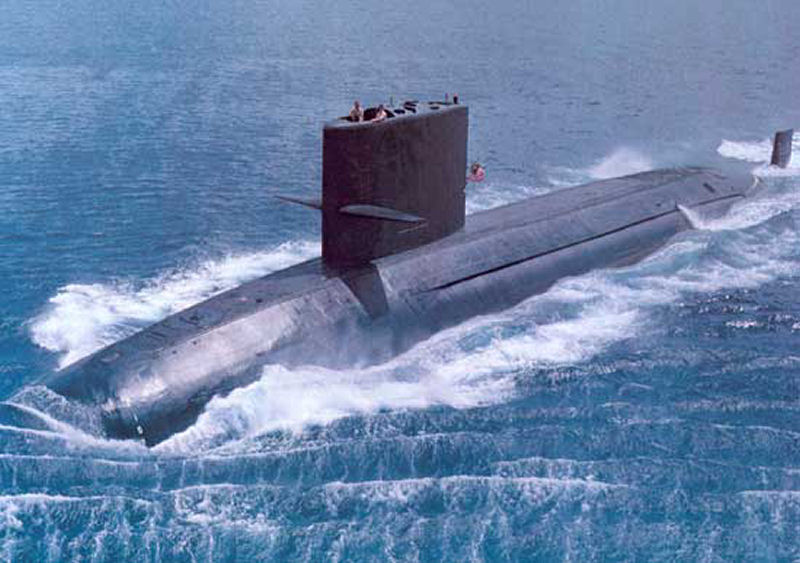
USS Bonefish underwent trials and training off New England in the spring of 1960 and transferred to the Pacific Fleet, arriving on 23 May so join SubDiv 33 at NS San Diego in California. She operated there until 16 September, and started for her first westPac.
She took part in exercises for the 7th Fleet stopping in Japan, Philippines, Marianas, Hong Kong until 13 March 1961. She had a first regular overhaul at Mare Island Naval Shipyard until 6 March 1962, resumed operations and made a second WestPac. By February 1963 she was homeported to Pearl Harbor and made a two-month WestPac. She then made a longer deployment from January 1964, with standdown and local operations and back to Pearl Harbor for upkeep.
In April 1966 she started her fourth Westpac and for the first time, Gulf of Tonkin operatiobns over seven-month until November.
She made a 5th tour and back in April 1968 for local operations, then regular overhaul until June 1969, and a 6th tour until back at Pearl Harbor in June 1970. Her 7th deployment started on 9 February 1971 and service with TF 77 in the Gulf of Tonkin, back on 10 August. She was awared the Meritorious Unit Citation for readiness for exceptional performance in 1969–1970.
After her last Westpack on 7 February 1972 she started another overhaul at Pearl Harbor Shipyard, including change of her snorkel piping system after fauled sea trials in March 1973. After refresher training and local operations over 10 months she was prepared to depart on 24 May 1974 to join the 7th Fleet, a routine deployment over 13 months.
On 6 December 1975 she made yet anbother tour of duty with joined exercises with the Korean and Taiwanese navies and the Japanese Maritime Self-Defense Force. On 25 April 1976 she was at Subic Bay and at Pearl Harbor on 15 May. She had a nearly yeat long overhaul, until 25 June 1977 followed a refresher training.
8 November saw her sailing out back to San Diego as home port, and from December 1977 she trained along the California coast and by 17 May 1978, started another western Pacific deployment, back at San Diego on 28 October, and local operations until 1979.
After her regular overhaul she started a South American cruise, from the Panama Canal to the Caribbean Sea, Trinidad, Tobago, Curaçao, Colombia, Venezuela, Netherlands Antilles and back via the canal, Ecuador, Peru, Chile and UNITAS. She stayed off California for the remainder of 1979 and 1980.
On 8 December 1980, she returned for a Westpack with the 7th Fleet and back on 14 July 1981. Then a cruiser to the east coast from 8 June 1982, via Panama on 23 June, Naval Station Charleston (new HP) on 6 July and by Augustj, taking part in NATO exercises in the North Atlantic, visiting Hamburg, Portsmouth, anc back to Charleston on 9 October.
She stayed in local waters until late 1983 followed by a 14-month overhaul at Charleston Shipyard. She was back in local ops. on 5 April 1984. Nothing of note 1985-88.
The accident and Decommission:
On 24 April 1988 USS Bonefish was submerged in an exercise with the guided-missile frigate USS Carr. She was c160 mi (260 km) off the Atlantic coast of Florida. Suddently, seawater started leaking onto cables and electric buses. This was a battery-supply cableway and this cause arcing, and then an explosion and a fire so violent thaty the temperature in the battery space reached 1,200°F (650°C). It melted shoes of passing bay crewmen in the space above.
The Captain ordered to surface, the captain ordered the crew to abandon ship, and whaleboat arrived from USS Carr as well as helicopters from nearby USS USS John F. Kennedy. Together they rescued 89 men. ASW Operator Petty Officer Third Class Larry B. Grossman which was an Aviation Rescue Swimmerand Diver jumped from an H-3 and spent three hours rescuing stricken sailors in the choppy waters. He saved 19 lives and later received the Navy and Marine Corps Medal from the President. Lieutenant Ray Everts, Radioman First Class Bob Bordelon, and Yeoman Third Class Marshal Lindgren died in the fire. The sub was later towed by a salvage-and-rescue ship to Charleston.
Damage assessment concluded ot was too extensive and decision was made to decommission her on 28 September 1988, stricken on 28 February 1989, scrapped from 17 August 1989 but the hull was purchased by Northrop Grumman for testing.
Read More/Src
Books
Friedman, Norman (1994). U.S. Submarines Since 1945: An Illustrated Design History. Annapolis, Maryland: United States Naval Institute. pp. 31–35, 242.
Bauer, K. Jack; Roberts, Stephen S. (1991). Register of Ships of the U.S. Navy, 1775–1990: Major Combatants. Westport, Connecticut: Greenwood Press.
Polmar, Norman and Moore, K. J. (2004). Cold War Submarines: The Design and Construction of U.S. and Soviet Submarines, 1945–2001. Dulles: Potomac Books.
Gardiner, Robert and Chumbley, Stephen, Conway’s All the World’s Fighting Ships 1947–1995, London: Conway Maritime Press, 1995.
Links
navsource.org/
nationalinterest.org/
hisutton.com
Internals
hnsa.org/ uss-blueback-ss-581/
omsi.edu uss-blueback-submarine/
navsource.org
qrz.com/db/w7sub
en.wikipedia.org/
navweaps.com/
navsource.org 8582.htm
navysite.de/ss/ss582acc.htm
chaoticsynapticactivity.com
oneternalpatrol.com
web.archive.org/ BONEFISH pdf
Videos
Final tour before decommissioning
Model Kits
https://www.super-hobby.com/products/USS-Barbel-class-submarine.html
https://sdmodelmakers.com/barbel-class-submarine-model-12-inch.html

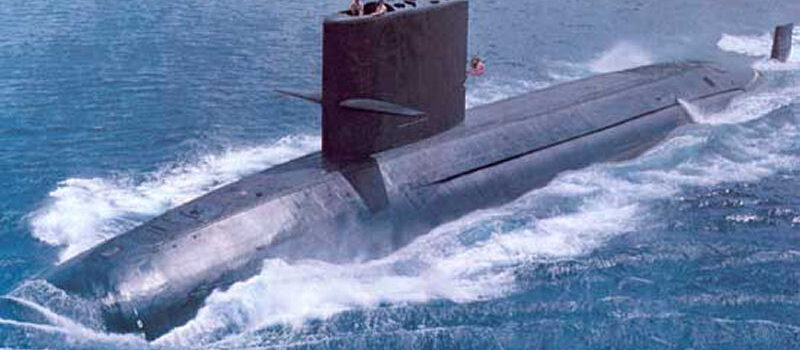

 Latest Facebook Entry -
Latest Facebook Entry -  X(Tweeter) Naval Encyclopedia's deck archive
X(Tweeter) Naval Encyclopedia's deck archive Instagram (@navalencyc)
Instagram (@navalencyc)





 French Navy
French Navy Royal Navy
Royal Navy Russian Navy
Russian Navy Armada Espanola
Armada Espanola Austrian Navy
Austrian Navy K.u.K. Kriegsmarine
K.u.K. Kriegsmarine Dansk Marine
Dansk Marine Nautiko Hellenon
Nautiko Hellenon Koninklije Marine 1870
Koninklije Marine 1870 Marinha do Brasil
Marinha do Brasil Osmanlı Donanması
Osmanlı Donanması Marina Do Peru
Marina Do Peru Marinha do Portugal
Marinha do Portugal Regia Marina 1870
Regia Marina 1870 Nihhon Kaigun 1870
Nihhon Kaigun 1870 Preußische Marine 1870
Preußische Marine 1870 Russkiy Flot 1870
Russkiy Flot 1870 Svenska marinen
Svenska marinen Søværnet
Søværnet Union Navy
Union Navy Confederate Navy
Confederate Navy Armada de Argentina
Armada de Argentina Imperial Chinese Navy
Imperial Chinese Navy Marinha do Portugal
Marinha do Portugal Mexico
Mexico Kaiserliche Marine
Kaiserliche Marine 1898 US Navy
1898 US Navy Sovietskiy Flot
Sovietskiy Flot Royal Canadian Navy
Royal Canadian Navy Royal Australian Navy
Royal Australian Navy RNZN Fleet
RNZN Fleet Chinese Navy 1937
Chinese Navy 1937 Kriegsmarine
Kriegsmarine Chilean Navy
Chilean Navy Danish Navy
Danish Navy Finnish Navy
Finnish Navy Hellenic Navy
Hellenic Navy Polish Navy
Polish Navy Romanian Navy
Romanian Navy Turkish Navy
Turkish Navy Royal Yugoslav Navy
Royal Yugoslav Navy Royal Thai Navy
Royal Thai Navy Minor Navies
Minor Navies Albania
Albania Austria
Austria Belgium
Belgium Columbia
Columbia Costa Rica
Costa Rica Cuba
Cuba Czechoslovakia
Czechoslovakia Dominican Republic
Dominican Republic Haiti
Haiti Hungary
Hungary Honduras
Honduras Estonia
Estonia Iceland
Iceland Eire
Eire Equador
Equador Iran
Iran Iraq
Iraq Latvia
Latvia Liberia
Liberia Lithuania
Lithuania Mandchukuo
Mandchukuo Morocco
Morocco Nicaragua
Nicaragua Persia
Persia San Salvador
San Salvador Sarawak
Sarawak Uruguay
Uruguay Venezuela
Venezuela Zanzibar
Zanzibar Warsaw Pact Navies
Warsaw Pact Navies Bulgaria
Bulgaria Hungary
Hungary

 Bundesmarine
Bundesmarine Dutch Navy
Dutch Navy Hellenic Navy
Hellenic Navy Marina Militare
Marina Militare Yugoslav Navy
Yugoslav Navy Chinese Navy
Chinese Navy Indian Navy
Indian Navy Indonesian Navy
Indonesian Navy JMSDF
JMSDF North Korean Navy
North Korean Navy Pakistani Navy
Pakistani Navy Philippines Navy
Philippines Navy ROKN
ROKN Rep. of Singapore Navy
Rep. of Singapore Navy Taiwanese Navy
Taiwanese Navy IDF Navy
IDF Navy Saudi Navy
Saudi Navy Royal New Zealand Navy
Royal New Zealand Navy Egyptian Navy
Egyptian Navy South African Navy
South African Navy






























 Ukrainian Navy
Ukrainian Navy dbodesign
dbodesign